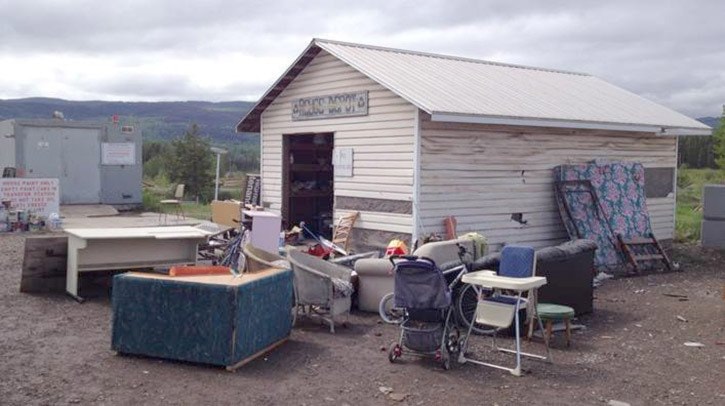A March 25, 2013 staff report from Janine Dougall, director or environmental services with the Regional District of Bulkley Nechako (RDBN), paints a scene of chaotic scavenging and salvaging at some of the RDBN solid waste management facilities across the region.
The report outlines a litany of refuse-site abuses.
Among the abuses are reports of intimidating and aggressive scavengers lingering around re-use sheds to smash and strip otherwise usable or recyclable electronics of their valuable metals, a scrap metal scavenger generating an estimated $50,000 in revenue by dragging scrap metal out of existing metal piles and then selling it, piles of metal rubbish left precariously unstable by salvaging activity, reports of rummagers hanging-out and consuming alcohol by the re-use shelters waiting for the arrival of fresh cast-offs, RDBN employees intimidated - even attacked in one instance - by confrontational scavengers, and the report of a child run over by a car in the distracting commotion surrounding the re-use shelters.
The child was unhurt, but the RDBN report cautions that children are sometimes left unattended at the re-use shelters while their parents use other areas of the facilities. Those unaccompanied children find shelter-interiors strewn with ‘dirty clothing, broken toys and soiled mattresses’ that never should have ended up in the sheds in the first place.
Historically, the RDBN allowed and encouraged salvaging as a nod towards reusing and recycling. According the report, the rise in the value of scrap metal over the last number of years has contributed to the frenzied escalation of scrap metal scavenging.
The increased value of scrap metal has meant a revenue stream for the RDBN, with approximately $485,000 of income through scrap metal recycling in 2011/12.
Despite the grim picture painted by the report, the re-use shelters remain immensely popular with users. At the April 18, 2013 RDBN board meeting, Directors Taylor Bachrach, Carmen Graff and Tom Greenaway each described the strong response they’ve received from members of their electorates regarding the sheds.
Bachrach reported over 99 per cent support for the sheds on an online Facebook poll he conducted to get a feel for public opinion. Graff said that he had never received so many phone calls on an issue. Greenaway stated that he was presented with a 208-person petition in favour of keeping the re-use sheds in operation.
“People love the dump,” said Bachrach speaking of people’s need for salvaging. “We can’t let a small number of people ruin it for everyone else. We need to look at strategies for those small numbers of people who are behaving inappropriately.”
Director Stoney Stoltenberg vocalized the sentiments of those who question the wisdom of allowing a basic free-for-all around the re-use sheds.
Stoltenberg was concerned that the RDBN is creating a lot of unnecessary work for transfer station staff to duplicate recycling options that are already available elsewhere.
For Stoltenberg, the re-use sheds started out as a great idea with a lot of volunteer support, but they’ve turned into a kind of feel-good garbage drop-off point .
“People just take their junk, throw it out and say, ‘There, I took it to the re-use shed’,” Stoltenberg said.
Directors Gerry Thiessen and Greenaway shared Stoltenberg’s concerns regarding the duplication of other local recycling or re-use efforts. The observation was made that in some cases the re-use sheds were actually adding to landfill piles.
“People bring perfectly good things there [to a re-use shed] such as a microwave, only to have some guy, within thirty seconds, rip the cord off [to salvage the copper], and then you’ve got a piece of junk,” said Theissen. “These re-use sheds and our waste transfer stations have been abused by a few individuals, and they’re starting to wreck it for everybody.”
Thiessen was concerned that despite a vocal contingent of salvagers signing petitions and responding to online polls, the public support for the re-use shed may be much less than presumed.
Greenaway suggested that clothing and small appliances could go to local thrift shops, rather than being left in re-use sheds where staff have to potentially deal with a mess.
In the end, a motion was approved that gives the re-use sheds a continuance. The three-part motion directs RDBN staff to investigate ways to address the problems associated with salvaging activities; to investigate adding additional staff to deal with the re-use sheds; and to ban large scale commercial metal salvaging.
Thiessen was the sole vote against the motion. He maintained that the re-use sheds, although well-intentioned, have not worked out as intended and take away from existing re-use options like local thrift stores.
By Walter Strong
Lakes District News
